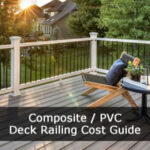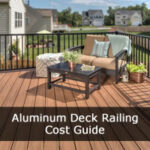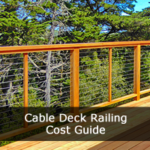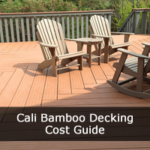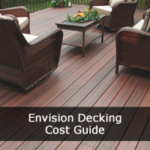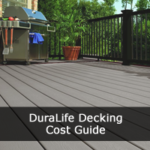Many homeowners have considered the wood vs composite decking dilemma.
What’s more important, a deck that boasts natural wood beauty and lovely wood aroma, even if it requires a lot more deck maintenance?
Or is a wood-look composite or plastic deck good enough, especially because it is nearly maintenance-free?
This guide to composite decking vs. wood decking will help you decide from these angles and more:
- Deck Cost: Wood deck cost vs composite deck prices
- Deck Cost Factors
- Pros and Cons: Wood vs. composite decks – The advantages and disadvantages of each
Both sections include the cost of popular wood types and the best-selling composite decking brands.
In this Cost Guide
Wood vs Composite Decking Costs
This table shows installed deck costs for the major wood types and composite brands.
| Deck Material / Brand | No Deck Railing | With Deck Railing | Deck Warranty |
| Wood Decking | |||
| Pressure-Treated Pine / Lumber | $9.75 | $13.90 | N/A |
| Red or White Cedar | $12.95 | $19.00 | N/A |
| Redwood | $14.50 | $21.25 | N/A |
| Ipe | $22.00 | $33.75 | N/A |
| Composite/PVC Decking | |||
| Trex Transcend | $14.25 | $20.35 | 25 years |
| Trex Select | $12.95 | $18.00 | 25 years |
| Trex Enhance Basic | $11.50 | $16.75 | 25 years |
| TimberTech AZEK | $20.40 | $27.15 | 50 years |
| TimberTech PRO | $17.50 | $24.30 | 30 years |
| TimberTech EDGE | $16.35 | $22.65 | 25 years |
| DuraLife Hardwoods | $18.00 | $24.35 | 25 years |
| DuraLife Landscapes | $17.65 | $23.40 | 25 years |
| Fiberon Paramount PVC | $12.85 | $19.80 | Lifetime |
| Fiberon Symmetry | $12.40 | $18.60 | 25 years |
| Fiberon ProTect Advantage | $11.50 | $11.50 | 25 years |
| Fiberon Good Life | $10.35 | $16.85 | 25 years |
| Cali Bamboo TruOrganics | $12.70 | $18.85 | 25 years |
| Cali Bamboo BamDeck 4G | $10.25 | $14.40 | 15 years |
- Deck Costs are per square foot.
- All costs reflect a pressure-treated wood substructure (Posts and the supporting frame of the deck)
Labor on most decks ranges from $3.50-$6.00 per square foot. Labor is included in these costs.
Did you Know? Most deck cost estimating sites calculate prices that are way too low. $4 per square foot for a pressure-treated wood deck? $7 for composite? That’s not going to happen, even if you DIY.
The problem is that most look at the cost of the deck boards – wood or composite – and use that to produce a deck cost estimate. Those boards are used for the deck boards, railings, steps and fascia.
Other potential deck costs include
- The pressure-treated substructure
- Fasteners
- Optional concrete to set the posts or concrete piers for posts to rest on
- Railings and steps when local code requires them or you want them for the aesthetics
- Fees for permits and inspections
- Labor costs, unless you DIY
We mention this because our deck prices are accurate – and we hope to prevent “sticker shock” when you see them. In fact, for most brands, we use cost calculators they provide to produce the most accurate deck prices for materials. Then, we add appropriate labor costs to get a total average cost for the decking you’re considering.
Deck Cost Factors
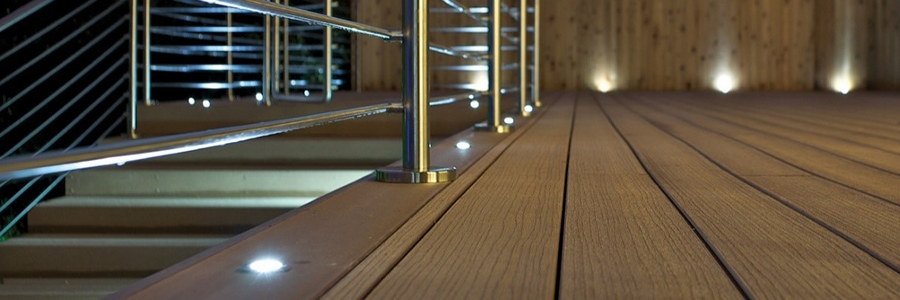
Let’s start with material factors and then consider labor factors.
Deck Material Cost Factors
- Wood Type: As you can see, price generally gets higher as wood progresses from treated pine all the way to ipe, also called Brazilian walnut.
- Wood Quality: Cedar, redwood and ipe are graded for quality and the clarity of the wood. Boards with fewer knots, mineral stains and other imperfections are graded higher and can cost significantly more.
- Wood Board Width: Wider pieces cost more per square foot for the simple reason that they are made from wider logs, which are less common.
- Composite Decking or PVC Decking Grade: As the table above shows, each deck manufacturer makes products in at least two grades and usually three grades.
- Railings or No Railings: If building code requires railings or you want them for the good looks they provide, materials and labor cost can be 40% higher.
- Substructure Material: Most decks are built with a pressure-treated substructure. A few brands makes a lightweight steel substructure option, and it can be costly. For example, Trex Elevations steel substructure costs about 35% more than a treated lumber substructure.
Deck Labor Cost Factors
We’ve mentioned that adding a railing and stairs means higher labor costs. Here are other cost factors.
- Who Does the Work: You’ll save $3.50 to about $6.00 per square foot of decking if you install it yourself. Of course, you might need to purchase or rent a few tools for the work, so there migth be some costs.
- Deck Design: Rectangular decks cost the least to build. As deck design gets more complex, more measuring and cutting is involved, so cost goes up. Multi-level decks can come with higher labor costs too. Stairs are time-consuming, so a long flight of stairs can really drive up labor cost.
- Terrain: Decks built on flat, bare terrain have lower labor costs than when the crew is working with a slope or has to remove shrubbery, stumps or a lot of rocks.
- Time of Year: Peak building periods differ by climate. Where winters are snowy, the peak season is late spring through summer. Cost estimates might be higher during that stretch than they would be as soon as the snow melts or into fall as snow threatens again.
- Where You Live: Decks, like everything else, cost more along the coasts, especially in the Northeast and Northwest and in major metropolitan areas. Costs are average in cities of the Midwest and South and lowest in rural areas.
- Note on ipe/Brazilian walnut: This wood is very hard. As a result, pilot holes are often drilled for the fasteners. This increases labor time and cost above the typical $3.50 – $5.50 or $6.00 per square foot.
Pros and Cons of Wood vs Composite Decks
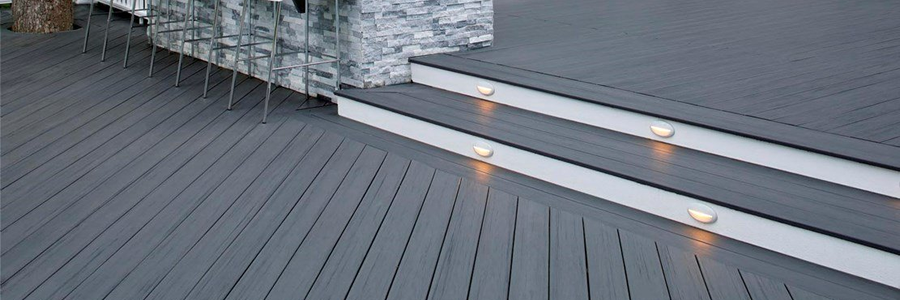
We’ll look at the pros of each first and then the cons.
Wood Deck Pros
- Natural wood is preferred for its genuine wood grain and woodsy aroma
- Cost of a treated or cedar deck is less than the mid-rage and expensive composite decking products
- Believe it or not, some homeowners enjoy cleaning and staining their deck every few years to refresh it – to make it look new all over again
- You can stain your deck or paint it in a wide range of hues and colors
Composite Deck Pros
- Composite wood and PVC is low-maintenance material that needs occasional washing but not staining or sealing
- The material resists stains and general weathering better than wood
- It is lighter than wood, especially PVC decking, so easier to work with
- The price of some composite decking is competitive with the cost of pricier wood decks
- Color, texture and style options are quite good for composite/PVC decking
- You get a materials warranty with most composite – and that’s rare for wood
Wood Deck Cons
- Maintenance – while some enjoy it, power-washing, repairing and staining/sealing a deck is a hassle for most homeowners
- Maintenance costs can drive up the lifetime cost of a wood deck to the point it costs more than composite
- Wood can split, crack, warp, etc., requiring costly repairs with new wood that won’t truly match the color of the old wood
- Splinters, insects and woodpeckers!
Composite Deck Cons
- Significantly higher upfront cost than the most affordable wood decks
- Plastic decks can have a higher surface temperature than most wood decks, to the point they are uncomfortable to walk on
- Cheap plastic decking looks just that – Cheap
- If spans are too great, composite and PVC will sag more than wood
- Can be slippery in wet weather, especially if mold or algae has been allowed to grow in shady areas of the deck
The Bottom Line: Wood Deck vs Composite Deck
The lower cost of treated wood and cedar vs the lower maintenance of composite and PVC is an important consideration.
But also consider:
How long will you live in the home? If it’s less than 10 years, you might not get good value from an expensive composite material or from ipe. If you plan to be there “forever,” then a good composite or PVC or elegant ipe deck is a better long-term value.
Appearance and Feel: Better grades of composite and PVC look a lot like real wood, but it aren’t, of course. PVC can feel plasticky too. Be sure to get samples of composite and PVC decking you’re considering. Does it look and feel enough like the “real thing” to satisfy you?
Green Considerations: Most composite and PVC decking has a good percentage of recycled material. But more energy and water are used in their production. PVC decking can be recycled quite easily. It isn’t as easy with composite. Wood, especially pine and cedar, is a renewable resource. Deck boards can be repurposed or used for fuel when your deck is replaced.
Related Decking Guides



